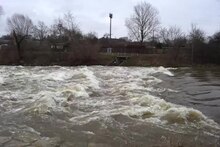Standing wave (current)

A standing wave is created on the surface of flowing water when the water flows over an obstacle. The obstacle can be large rocks lying at the bottom of the river. A step in the river bed can also be the cause. In order for the standing wave to be clearly perceptible, the water must flow so quickly that it is neither slowed down significantly by the obstacle nor shifts to the side.
Standing waves are one of the challenges for those who enjoy white water paddling . Occasionally, standing waves are big and steady enough that surfboards can ride them.
Artificial waves
One of the first artificial waves was the Eisbach wave in Munich. A suitable basic shape was available here, which was optimized by local surfers. Other waves or rollers are at Plattling and in the Augsburg Ice Canal . In 2001 the Radetzky wave for kayakers and surfers was built in Graz (Austria) . In 2003 the kayak freestyle world championship took place there. The Almwelle in Salzburg was built in 2010.
In November 2019, the start-up Wellenwerk Berlin opened the first inline shaft in the capital, in a converted warehouse at the Lichtenberg intermediate pumping station . Surfing can be learned there under supervision . Surfing is listed as an Olympic discipline at the 2020 Summer Olympics .
Individual evidence
- ↑ wave projects , lecture in 2013 by M. Stroemer
- ^ Redesign of the Radetzkywelle Facebook entry from January 17, 2016
- ↑ Surfwelle on the Almkanal , waterworks cooperative Almhauptkanal, accessed on February 2, 2016
